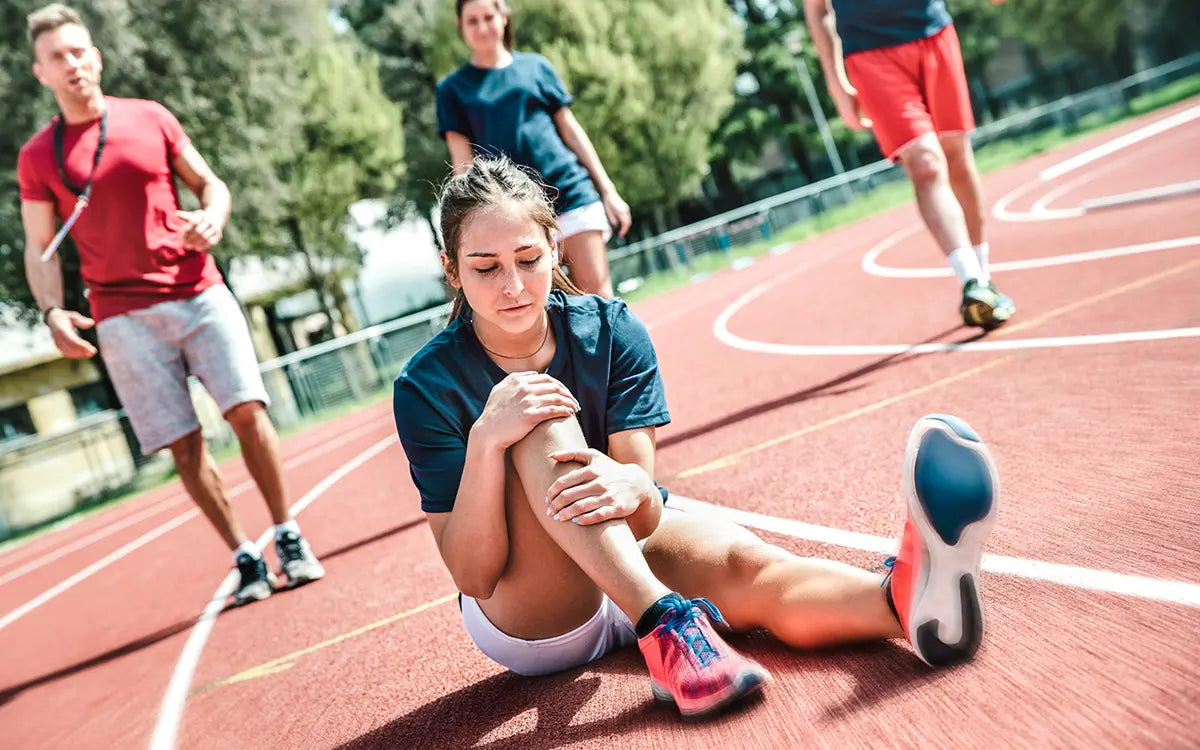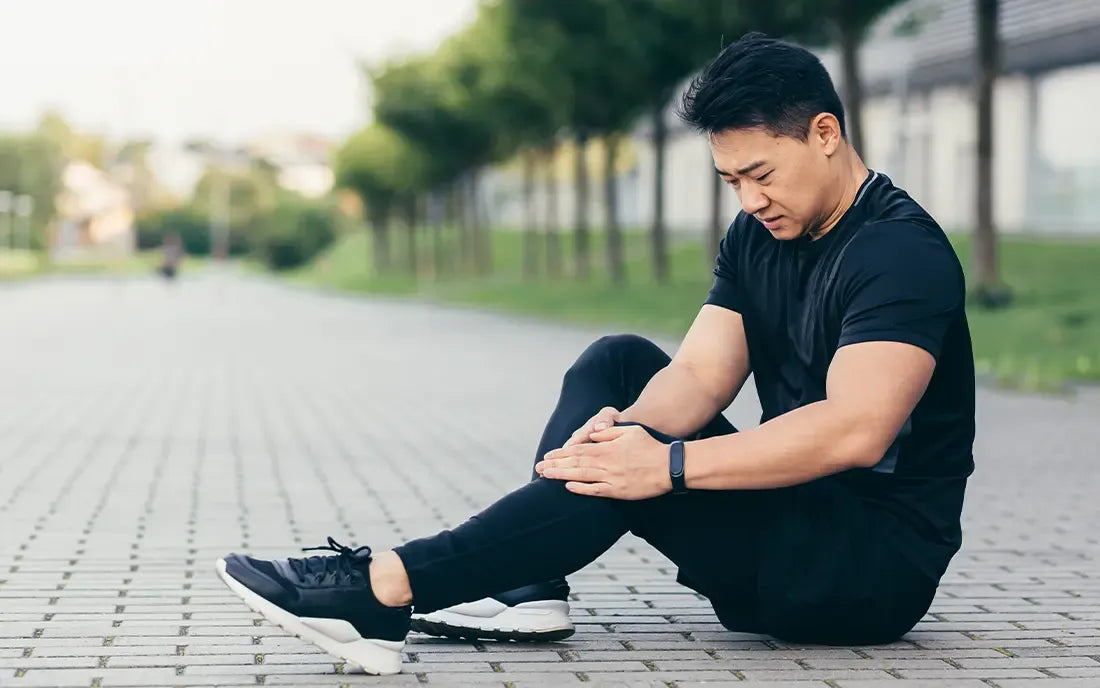We all know the joy of being active and doing what we love—but it's important to know the risks our bodies may face while hitting the gym, field or court.
Every year, millions of people find themselves on the sidelines due to sports injuries. But while we can't prevent every injury—you can definitely take steps to reduce the risk.
When it comes to sports injuries, there are two main types you need to know about acute and chronic.
Acute injuries happen suddenly, catching you off guard, while chronic injuries creep up on you over time and are a direct result of repetitive stress or overuse of certain body parts.
By knowing the different types of sports injuries, you'll be one step closer to preventing them.
That’s where we step in. In this Smart Guide, we’ll look at why we get injured, the most common injuries, how to prevent them—and how supplements can help the healing process.
Let’s dive in.
Why do we get injured?
Have you ever found yourself wondering why those pesky injuries keep popping up out of nowhere?
Whether you’re an elite athlete or a weekend warrior, the guiding principles of treating and preventing common sports injuries remain the same.
Let’s look at some of the top reasons why athletic injuries occur and provide some insight on how to prevent them.
Overuse
The overuse of muscles, tendons, and joints can lead to fatigue and the development of muscle strains and cramps.
Often, this happens due to a lack of sufficient rest and inadequate time for the muscles to recover and heal.
So, coaches, as well as athletes, must know the importance of cross-training and engaging in alternative activities with different styles, tempos, and intensities to keep the body conditioned.
SmartTip: Check out our guide to essential strength and conditioning exercises to prime your body for sporting success while helping to prevent injury.
Doing too much too soon
The mantra of ‘too much too soon’ often becomes prevalent when athletes are on Injured Reserve or dealing with acute or chronic injuries.
Many athletes believe they can return to their pre-injury performance levels immediately. But, this isn’t the case.
After being medically cleared to play, athletes should start with only 10% of the intensity of their normal workouts in their first session.
Imbalanced training sessions
Imbalanced training sessions can lead to long-term deformities and imbalances.
Just like the person in the gym who focuses solely on their upper body and neglects their lower extremities—athletes can get carried away with working on specific muscle groups without looking at the bigger picture. And, when you do this often, injuries can start to form.
Improper rehabilitation
During the rehabilitation phase of common sports injuries, therapists need to consider two challenges that athletes must overcome.
The first challenge is the complete healing of the damaged structure and tissue, while the second challenge is the reconditioning of the musculotendinous complex.
Modalities used during early rehabilitation may include stretching, range of motion exercises, gait training, iontophoresis, electrical stimulation, shockwave physical therapy, PRP, and amnio therapy.

The main types of sports injuries explained
Sports injuries are as diverse as the athletes themselves. Each type of injury brings with it unique symptoms and complications.
Let's dive into the most common sports injuries that you should know about…
Sprains
When ligaments, which are the tissue that connects bones in a joint, are overstrained or torn, a sprain occurs. This can result in pain, swelling, and limited movement in the affected joint.
Strains
Muscles and tendons can also be over-strained or torn, leading to a strain. Tendons are the thick, fibrous cords of tissue that connect bones to muscles. It's important to note that strains are often mistaken for sprains—but a sprain usually relates to an issue with the ligaments rather than the muscles or tendons.
Knee injuries
Any injury that affects the movement of the knee joint can be classified as a sports injury. From overstretching to tears in the muscles or tissues around the knee, these injuries can range in severity and require appropriate treatment and rehabilitation.
Swollen muscles
Swelling is a natural response to an injury, and it often accompanies sports-related muscle damage. Swollen muscles can cause pain and weakness, indicating the need for proper rest and recovery strategies.
Achilles tendon rupture
Located at the back of your ankle, the Achilles tendon is a vital structure. But, during intense sports activities, this thin yet powerful tendon can rupture or break. As a result, you may experience sudden and severe pain, as well as difficulty walking.
Fractures
In more severe cases, bones can actually fracture or break. These fractures can occur anywhere in the body and may require medical intervention such as casting, bracing, or even surgery.
Dislocations
Another type of sports injury involves the dislocation of a bone. This happens when a bone is forced out of its socket, often resulting in intense pain, swelling, and weakness. Proper treatment and rehabilitation are needed to restore stability and functionality.
Rotator cuff injury
The rotator cuff is a group of four muscles that work together to facilitate movement in the shoulder joint. Any tear or damage to these muscles can weaken the entire rotator cuff, impacting your ability to move your shoulder in different directions.
The most common gym injuries uncovered
We all know that the sports we play can have a big impact on the types of injuries we may encounter.
But don't worry, we’re here to empower you with the smartest knowledge about the most minor sports injuries out there.
Achilles tendon injuries
Achilles tendonitis, which is a common injury to this mighty tendon, often happens in sports that involve a lot of running.
Not enough stretching before playing, wearing the wrong shoes, or suddenly intensifying your sports activities can contribute to this injury.
Keep an eye out for symptoms like heel or calf pain when you walk or run, swelling, or warmth in the affected area.
These injuries can be either acute, happening suddenly, or chronic, developing over time and lingering around for quite a while.
Broken bones and stress fractures
A broken bone, or fracture, occurs when a sudden external force is applied to a bone—and it can happen in almost any sport.
This can cause quite a bit of discomfort, with symptoms such as sudden pain, swelling, numbness, tenderness—and even a change in the appearance of the affected area.
On the other hand, stress fractures are a bit sneaky as they are chronic injuries that develop slowly over time due to repetitive motions.
These motions cause tiny cracks in your bones, which can be a real pain. In fact, sometimes you might not even realise you have a fracture until it starts causing noticeable pain.
Rotator cuff injuries
Your rotator cuff is an essential part of your shoulder that helps with movement and stability.
Repetitive actions, like the ones you find in swimming, tennis, or baseball, can often lead to injuries in this area.
Symptoms of a rotator cuff injury include swelling in the shoulder, pain when lifting your arm, and discomfort when reaching behind your back.
This injury tends to be chronic—but there are times when it can show up suddenly as an acute injury.
Runner's knee
This is a really pesky one that’s commonly experienced by runners or anyone who spends a lot of time walking, biking, or bending their knees.
Symptoms include pain behind your kneecap, especially during knee bending, swelling, and even a grinding sensation.
Keep in mind that a runner's knee can be acute or chronic—so it's essential to take it seriously and work through the necessary steps to recover.
Shin splints
These can really put a cramp in your stride, especially if you're a runner or a basketball enthusiast. Shin splints occur when the muscles and tendons surrounding your shin become inflamed.
The main symptom here is pain in the front of your lower leg while you're in the heat of the sport.
The good news is that rest often helps alleviate the pain. Shin splints fall under the acute injury category—so give yourself some much-deserved rest—and you'll be back on your feet in no time.
Sprains
One of the most common injuries out there—a sprain happens when a ligament near a joint, like your knee, ankle, or wrist, gets stretched or torn.
This can happen due to a fall or a sudden twisting motion. A more serious sprain injury is an anterior cruciate ligament.
You might experience pain, swelling (sometimes severe), bruising, and find it challenging to put weight on the joint without feeling pain.
These injuries are acute—so it's important to give yourself some time to heal and seek proper medical attention if needed.

How to prevent sports injuries: top tips
When it comes to preventing sports injuries, taking a proactive approach is key. Let's dive into some effective tips to keep you in the game and injury-free.
First, warm up and stretch before your activity. Cold muscles are more likely to overstretch and tear, while warm muscles are flexible and can handle quick movements.
Next, pay attention to your technique. Different sports and activities require specific movements and postures. By learning the proper way to move, you can avoid putting unnecessary strain on your body.
Prime yourself for success by wearing the right shoes and protective gear. Ill-fitting shoes or improper equipment can increase your risk of injury. So, take the time to find the perfect fit and gear up before you hit the field or court.
Now, here's an important reminder—don't overdo it. If you do get injured, give your body the time it needs to heal. Pushing through the pain might do more harm than good.
Once you're healed, ease back into your activity gradually.
After your workout or game, don't forget to cool down. Just like a warm-up, a cool-down is essential in preventing injury. Take a few minutes to do the same stretches and exercises from your warm-up routine.
And when it's time to get back to your activity after an injury, don't be afraid to resume slowly. It's tempting to jump back in at the same intensity, but taking it easy is the smarter choice.
Excessive rest can delay healing, so find that sweet spot between giving yourself time to recover and gradually getting back into the swing of things.
Can supplements help with sports injuries?
Yes, they can. Recovery supplements are available in a variety of options. You can take them individually, combined, or as part of a dedicated recovery blend.
Their main purpose is to replenish and revitalise your muscles—as well as other parts of your body—after an intense workout.
Let’s take a look at some of the best ones to consider.
Whey Protein
To kickstart the rebuilding and recovery process, it’s important to stimulate muscle protein synthesis—the process of our body's tissues starting to build and repair themselves.
To support this rebuilding process and foster the growth of bigger, stronger muscles, you need to get your daily fill of protein.
By fueling your body with whey protein, you’re giving it the necessary tools to repair and grow your muscles.
BCAAs
BCAAs, which include valine, leucine, and isoleucine, are part of the exclusive club known as essential amino acids.
You can find BCAAs in various protein-rich foods, such as juicy meats and wholesome eggs. But if you're looking for a convenient way to ensure you're getting enough, BCAA supplements are a solid choice.
Creatine
Our natural levels of creatine can vary from person to person. But don’t sweat it, because supplementing with creatine has been shown to be a helpful tool in elevating your stores for the best athletic outcomes.
When you use creatine, you’re preparing your muscles to be strong, powerful, and ready to rock your next workout. Bonus.

Boost your post-workout the Smart way
Not sure where to start when it comes to post-workout supplements? Let us set you on the path to recovery and recuperation and allow you to keep training hard.
Make sure your body gets back to its very best after exercise with our top products for optimising the post-activity recovery process.
With whey protein for muscle repair, restorative electrolytes, and gummies for better joint health, The Recovery Kit has all you need to keep you fresh, sharp, and recharged after spurts of intense activity. Go for it.
SOURCES
Smart Protein is committed to sourcing only the best and scientifically-based research in our articles.
1. UK Sport:
https://www.uksport.gov.uk/news/2012/07/25/battle-against-injury-and-illness

